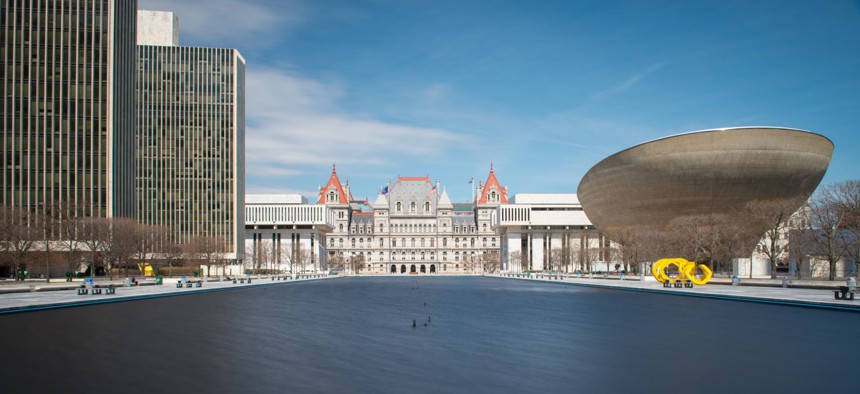New York Competition Will Focus on Local Government Consolidation, Restructuring

Empire State Plaza in Albany, New York Shutterstock
A winning consortium of jurisdictions will be eligible for about $20 million.
Local governments in New York will get a chance to vie for a roughly $20 million state award by presenting plans for consolidation and efficiency measures meant to reduce property taxes.
The Municipal Consolidation and Efficiency Competition was announced by Gov. Andrew Cuomo, a Democrat, on Thursday. The program calls for groups of two or more local jurisdictions to submit plans to the state for government consolidations, shared services and other restructuring initiatives.
"Property taxes remain the most burdensome tax in New York and with this competition, we are incentivizing local governments to band together to think outside the box, streamline their bureaucracies, cut costs and deliver real relief to their taxpayers," Cuomo said in a statement.
Lead applicants in the competition must be cities, towns, or villages with populations over 50,000, or counties. Localities with fewer people can apply as non-lead partners. In addition to finding ways to lower property taxes, the competition is aimed at reducing the number of local governments in New York, and testing and sharing new consolidation and efficiency practices.
The award money would be made available to help implement the winning consortium’s proposals.
“It’s a substantial amount of money,” Stephen Acquario, executive director of the New York State Association of Counties, said by phone Thursday. “I think the counties will look at it.”
Acquario explained that, since the Great Recession, counties in New York state have already taken significant steps to consolidate, merge, eliminate and privatize services, such as public health clinics, mental health clinics and nursing homes.
Some have also looked to share resources like trucks for public works, coroners and medical examiners, he said. And, in certain instances, counties have worked together on purchasing, payroll and information technology.
“There’s not much more that we can do to merge or abolish as a unit of government,” Acquario added.
But he does believe there are opportunities for counties to join with local jurisdictions like cities, towns and villages to achieve cost savings. “I think most of the counties, if not all of them, would be willing to talk with any of its units of local government about this competition,” Acquario said.
He noted that consolidations can become sensitive and encounter opposition if residents feel like the identity of their locality might get lost or eroded.
In the backdrop of Cuomo’s program are state-mandated costs, which consume the bulk of the property tax revenue collected in New York’s counties.
According to the Association of Counties, New York law requires counties there to implement and finance more than 40 programs controlled and defined by the state.
Some of these include public assistance for adults and families, criminal defense and legal services for the poor, child welfare, preschool special education, and Medicaid, which provides access to health care coverage for people with low incomes.
“If they didn’t mandate the counties to pay $8 billion in Medicaid, we wouldn’t even be having this discussion,” Acquario said.
New York’s Department of State will oversee the competition program. A panel selected by Secretary of State Rossana Rosado is slated to choose a winning consortium, which will be announced in summer 2017.
More information about the program can be found here.
Bill Lucia is a Reporter for Government Executive's Route Fifty and is based in Washington, D.C.
NEXT STORY: Revenge of the Forgotten Class






